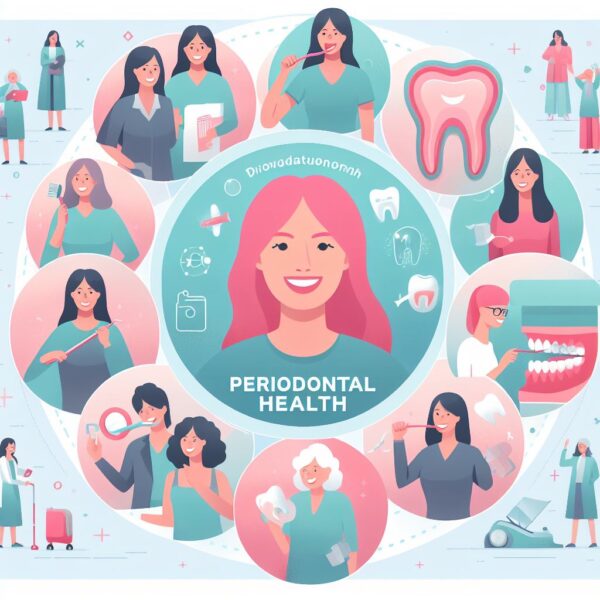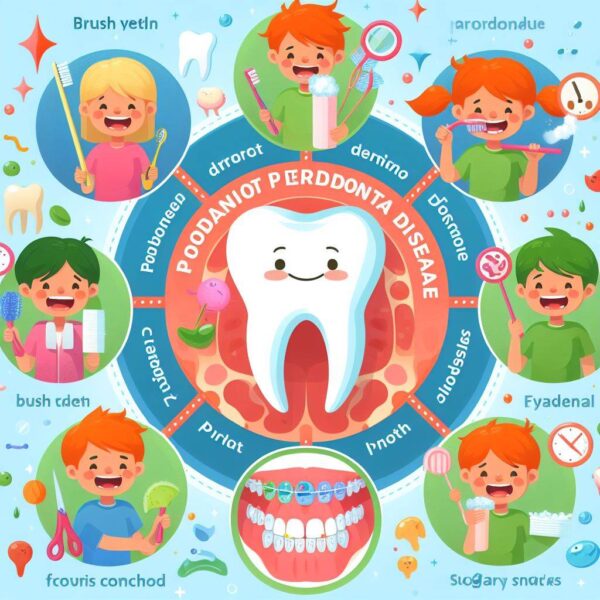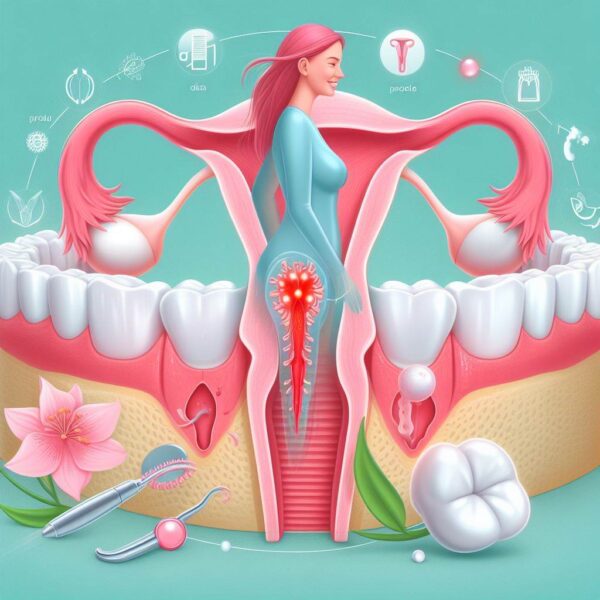
Periodontal health, encompassing the condition of the gums and supporting structures of the teeth, is a vital aspect of overall oral health and well-being. In recent years, research has shed light on the unique relationship between periodontal health and women’s health, highlighting the influence of hormonal fluctuations, life stages, and systemic conditions on the gums and oral tissues.
From puberty to pregnancy, menopause, and beyond, women experience various hormonal changes that can impact their susceptibility to gum disease and oral health outcomes.
Understanding these nuances is essential for healthcare professionals and women alike to promote preventive strategies, early detection, and tailored interventions to optimize periodontal health throughout different stages of life.
In this article, we’ll explore the intricate interplay between periodontal health and women’s health, examine the factors that influence gum disease risk in women, and discuss the importance of proactive oral care measures for maintaining healthy gums and a radiant smile at every age.
Periodontal Health In Women

Periodontal health is influenced by a myriad of factors, including genetics, oral hygiene practices, systemic health conditions, and hormonal fluctuations.
In women, hormonal changes associated with puberty, menstruation, pregnancy, and menopause can affect the gums and oral tissues, potentially increasing the risk of gum disease and other oral health issues.
Exploring Periodontal Health In Women:
1. Puberty:
During puberty, hormonal changes, particularly increased levels of estrogen and progesterone, can affect the blood flow to the gums, making them more sensitive and prone to inflammation. This may lead to symptoms such as swollen, red, or bleeding gums, especially in individuals with poor oral hygiene habits.
2. Menstruation:
Hormonal fluctuations during the menstrual cycle can also influence gum health, with some women experiencing gingival inflammation or swelling in the days leading up to their period. This menstrual gingivitis typically resolves after menstruation but may recur with each cycle in susceptible individuals.
3. Pregnancy:
Pregnancy gingivitis is a common oral health concern among pregnant women, characterized by increased gum sensitivity, swelling, and bleeding. Hormonal changes, along with the presence of plaque and bacteria, can exacerbate gingival inflammation during pregnancy, emphasizing the importance of regular dental care and oral hygiene.
4. Menopause:
Menopausal women may experience changes in oral health-related to declining estrogen levels, including dry mouth, burning sensation in the mouth, altered taste perception, and an increased risk of gum disease and tooth loss. Hormone replacement therapy may help alleviate some of these symptoms and support periodontal health in menopausal women.
5. Systemic Health Conditions:
Certain systemic health conditions that are more prevalent in women, such as osteoporosis, diabetes, and autoimmune diseases, can also impact periodontal health. Osteoporosis, in particular, is associated with decreased bone density, which can affect the stability of the teeth and increase the risk of periodontal disease.
6. Oral Contraceptives:
Some studies suggest that oral contraceptives (birth control pills) may influence gum health by altering hormone levels and increasing the risk of gingival inflammation and gum disease in certain women. Regular dental check-ups and good oral hygiene practices are essential for women using oral contraceptives to maintain periodontal health.
7. Oral Hygiene and Preventive Measures:
Regardless of life stage or hormonal fluctuations, maintaining good oral hygiene habits, such as brushing teeth twice a day, flossing daily, and visiting the dentist regularly for check-ups and cleanings, is essential for preserving periodontal health.
Additionally, avoiding tobacco use, eating a balanced diet, and managing systemic health conditions can support gum health and overall well-being in women. I hope now you’re aware of Periodontal Health In Women.
Why Does It Matter?

Periodontal health, often overlooked in discussions of women’s health, plays a pivotal role in overall well-being. While oral health is important for everyone, it holds particular significance for women due to the unique hormonal fluctuations they experience throughout life.
From puberty to pregnancy, menopause, and beyond, hormonal changes can profoundly impact the gums and supporting structures of the teeth, influencing susceptibility to gum disease and oral health outcomes.
Understanding the intricate interplay between periodontal health and women’s health is crucial for healthcare professionals and women alike. In this article, we’ll delve into why periodontal health matters specifically for women, exploring the implications of hormonal changes, life stages, and systemic conditions on gum health.
By shedding light on this often-overlooked aspect of women’s health, we aim to empower women to prioritize their oral health and take proactive steps to maintain healthy gums and a radiant smile at every stage of life.
Exploring The Importance Of Periodontal Health In Women:
1. Hormonal Fluctuations:
Hormonal changes associated with puberty, menstruation, pregnancy, and menopause can affect the blood flow to the gums, making them more susceptible to inflammation and infection. Fluctuations in estrogen and progesterone levels can exacerbate gum disease symptoms and increase the risk of gingival issues.
2. Pregnancy and Oral Health:
Pregnancy gingivitis is a common oral health concern among pregnant women, characterized by increased gum sensitivity, swelling, and bleeding. Hormonal changes during pregnancy, along with the presence of plaque and bacteria, can contribute to gingival inflammation and gum disease if left untreated.
3. Menopause and Oral Health:
During menopause, declining estrogen levels can lead to changes in oral tissues, including decreased saliva production, dry mouth, and an increased risk of gum disease. Menopausal women may also experience oral discomfort, altered taste perception, and other oral health issues related to hormonal changes.
4. Systemic Health Conditions:
Certain systemic health conditions that are more prevalent in women, such as osteoporosis and autoimmune diseases, can impact periodontal health. Osteoporosis, characterized by decreased bone density, can affect the stability of the teeth and increase the risk of tooth loss and gum disease.
5. Oral Contraceptives and Hormonal Therapy:
Some studies suggest that oral contraceptives (birth control pills) and hormonal therapy may influence gum health by altering hormone levels and increasing the risk of gingival inflammation and gum disease in certain women. Regular dental check-ups and good oral hygiene practices are essential for women using hormonal medications to maintain periodontal health.
Periodontal Health & The Female Life Cycle

The female life cycle is marked by a series of transformative stages, from puberty to pregnancy, menopause, and beyond. Throughout these milestones, women experience profound hormonal fluctuations that can influence various aspects of health, including oral health.
Periodontal health, encompassing the condition of the gums and supporting structures of the teeth, is particularly susceptible to hormonal changes, making it a crucial aspect of women’s overall well-being.
Understanding the intricate interplay between periodontal health and the female life cycle is essential for healthcare professionals and women alike.
In this article, we’ll explore how hormonal fluctuations during puberty, menstruation, pregnancy, and menopause impact periodontal health, examine common oral health concerns at each life stage and discuss proactive strategies for maintaining healthy gums and a radiant smile throughout the female life cycle.
Exploring Periodontal Health & The Female Life Cycle:
The female life cycle encompasses several key stages, each characterized by distinct hormonal changes that can influence periodontal health. Here’s a detailed exploration of how periodontal health intersects with the female life cycle:
1. Puberty:
During puberty, hormonal changes, particularly increases in estrogen and progesterone levels, can affect blood flow to the gums, making them more susceptible to inflammation and infection. Puberty may also coincide with the onset of orthodontic treatments, which can impact oral hygiene and gum health.
2. Menstruation:
Hormonal fluctuations during the menstrual cycle can exacerbate gingival inflammation and swelling in some women, leading to symptoms such as bleeding gums or discomfort. While menstrual gingivitis typically resolves after menstruation, it may recur with each cycle in susceptible individuals.
3. Pregnancy:
Pregnancy is a period of significant hormonal changes, with increases in estrogen and progesterone levels contributing to gingival inflammation and increased susceptibility to gum disease. Pregnancy gingivitis is a common oral health concern among pregnant women, highlighting the importance of regular dental care and oral hygiene.
4. Menopause:
Menopause marks the end of the reproductive years and is accompanied by declining estrogen levels, which can lead to changes in oral tissues, including decreased saliva production, dry mouth, and an increased risk of gum disease. Menopausal women may also experience oral discomfort and altered taste perception.
5. Postmenopausal Years:
In the postmenopausal years, women may face additional oral health challenges related to aging, such as tooth loss, bone resorption, and oral dryness. Maintaining regular dental check-ups, good oral hygiene practices, and a healthy lifestyle is essential for preserving periodontal health and overall well-being.
Abstract

Periodontal health, crucial for overall well-being, is particularly significant for women due to hormonal fluctuations experienced throughout their lives. From puberty to pregnancy, menopause, and beyond, these hormonal changes profoundly impact gum health.
Understanding the abstract of studies on periodontal health in women is vital for healthcare professionals and researchers. It provides a concise overview of research objectives, methods, findings, and implications, offering insights into the influence of hormonal fluctuations on gum health in women.
In this article, we’ll delve into the essence of the abstract for such studies, exploring its purpose, structure, and significance in communicating key findings, implications, and recommendations for promoting oral health and well-being among women across various life stages.
Exploring The Abstract For Periodontal Health In Women:
The abstract typically begins with an introduction, summarizing the importance of understanding hormonal influences on periodontal health in women. It sets the stage for the study’s objectives and relevance.
• Objectives:
Next, the abstract outlines the study’s objectives, which may include investigating the association between hormonal fluctuations and gum disease prevalence or severity.
• Methods:
Researchers detail the methods employed, such as study design, participant selection criteria, and assessment tools used to evaluate periodontal health and hormonal status.
• Findings:
The abstract presents key findings, highlighting any significant associations between hormonal fluctuations and periodontal health outcomes. This may include prevalence rates, severity of gum inflammation, or risk factors identified.
• Implications:
Discussion of implications follows, focusing on the clinical relevance of findings. It may emphasize the importance of tailored interventions for women during hormonal changes, like puberty, pregnancy, or menopause, to promote gum health.
• Recommendations:
Finally, the abstract concludes with recommendations for clinical practice and future research. It may suggest implementing preventive strategies targeting hormonal fluctuations and advocating for further investigation into this area.
Conclusion:
Understanding periodontal health in women is crucial for promoting overall well-being and quality of life. From puberty to pregnancy, menopause, and beyond, women experience hormonal fluctuations that can profoundly impact gum health.
By prioritizing regular dental check-ups, practicing good oral hygiene habits, and being mindful of hormonal changes during various life stages, women can take proactive steps to maintain healthy gums and reduce the risk of periodontal disease.
Additionally, raising awareness of the importance of periodontal health in women among healthcare professionals and the general public can contribute to improved oral health outcomes and overall wellness for women everywhere. I hope now you are fully aware of Periodontal Health In Women and everything related to it.
FAQs:
Q1: Does hormonal fluctuation during menstruation affect gum health in women?
A: Yes, hormonal fluctuations during the menstrual cycle can exacerbate gum inflammation and may lead to symptoms such as bleeding gums or discomfort in some women.
Q2: Is pregnancy gingivitis common, and how can it be managed?
A: Pregnancy gingivitis is relatively common among pregnant women due to hormonal changes. It can be managed through regular dental check-ups, professional cleanings, and maintaining good oral hygiene habits.
Q3: Are women more susceptible to gum disease during menopause?
A: Yes, women may be more susceptible to gum disease during menopause due to declining estrogen levels, which can lead to changes in oral tissues and an increased risk of gum inflammation and infection.
Q4: Can oral contraceptives influence periodontal health in women?
A: Some studies suggest that oral contraceptives (birth control pills) may affect gum health by altering hormone levels, increasing the risk of gum inflammation, and gum disease in certain women.
Q5: What preventive measures can women take to maintain periodontal health?
A: Women can maintain periodontal health by practicing good oral hygiene habits, including brushing their teeth twice a day, flossing daily, avoiding tobacco use, eating a balanced diet, and scheduling regular dental check-ups and cleanings.
